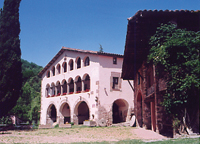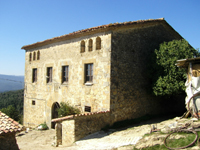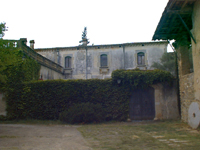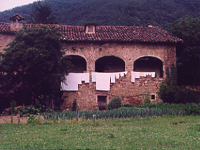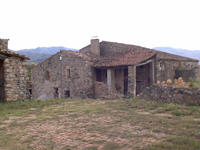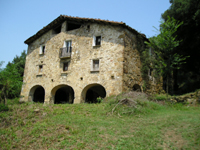la Garrotxa |
el Molí d'en Solà
la Vall de Bianya (Garrotxa)La Garrotxa: a land covered with Farmhouses
Catalunya is a very old country. In order to understand our landscapes, which have often been transformed by man, it is usually necessary to go back hundreds of years and maybe even thousands. In many regions of Catalunya, the farmhouse is one of the Basic elements that allow us to understand the landscape that has evolved to the present day. Alongside the farmsteads, the landscape offers other interesting object that man has moulded, well worth getting to know: villages, mills, footpaths, fields and pastures.
However in order to understand the role of the sparse habitat, we must also examine the past and the population that existed during the Carolingian period. We need to be aware of the social changes that occurred after the year 1000, and even analyse the power struggles that existed between the laymen and the clergy during these remote times. It is also necessary to know how important violence was during those times, especially if this was brought by outsiders, since it is well known that this tends to favour a certain concentration and fortification of populated places.
During the Carolingian era, our country was covered with tiny settlements, small-populated centres, made up of a few houses, where several families lived. It is true that sometimes even before the year 1000 there was an occasional isolated house between the fields and the woodlands under a rock or close to a meadow. It was however throughout the eleventh, twelfth and thirteenth centuries and during the first decades of the fourteenth century when the number of farmhouses increased, at the same time as the population in the territory increased in a similar way as had occurred in the rest of Europe. Some of the old medieval villages and the Carlomagno settlements became farming exploitations run by a single family. At the same time there was an increase in the number farmers' homes which unfolded (mas jussà and mas sobirà, mas d'amunt and mas d'avall), separated a few hundred metres apart. The appearance of huts, shacks and cabins also occurs (which were smaller houses), situated on marginal strips of land. Eventually the farm labourer's dwellings developed; the farm labourers who lived there paid taxes not only to the “ Lord of Manor” , but also to the farmer, often the same farmer that had segregated them.
The farming exploitation became smaller and smaller. Every corner of la Garrotxa was filled with farming and livestock exploitations, some large, small middle-sized and in many cases too small to be able to ensure the survival of a family. The demographic crisis brought on due to famine and disease during the fifteenth and sixteenth centuries, saw the disappearance of many farms that were left uninhabited and in ruins.
These farmland ruins in turn were exploited by the farmers that had continued to live in the larger. The existence of rich farmers, who already enjoyed the ownership and the use of these barren farms, was consolidated legally with the Sentence of Guadalupe and the end of the fifteenth century. During the seventeenth and eighteenth centuries, demographic recovery saw an inversion of this process: many of the old barren farms gave work to farm labourers and the farmhouses were once again occupied by the labourers, who depended on the larger farmhouses, in many cases the large country homes that have survived throughout to this century. This evolution, thanks to the conservation of documentation can be analysed in detail on many municipalities of the region. (Santa Pau, Mieres, Montagut de Fluvià, Vall d'en Bas, les Preses, Sant Feliu de Pallerols etc.); we can therefore uncover the origins of many of the current farms and understand how the large prominent farmhouses that we still treasure today came in to being, often due to the reconstruction work carried out in the eighteenth and nineteenth centuries.
We must also take note that, at the same time as the farmhouses extended throughout the territory the first villages became established. These were usually ecclesiastic villages that arouse around a church, within its sanctuary, the holy space that measured some thirty feet around the church. In the region of la Garrotxa there is not much castledoms (for example Santa Pau and el Mallol); even in Oix, the village originates around the church and the castle is separated from the centre of the village. The old castles such as those to be found at Finestres, Castelló or Bestracà, which date from the high middle ages, had been built on unfavourable sites and they lost importance soon after the year 1000. The role that the church sanctuaries played as centres that concentrated a good part of the population leads us to the consider the extent of the influence that the church maintained in these places at the beginning of the second millennium even though they were faced with a new and increasing non-religious nobility. However, we must also take into account that in many parishes the process of dispersion of farmhouses spreading throughout the land outweighed the inertia that lead to the concentration of people around the religious buildings. We can find many examples of churches where no houses have been built in the thirty feet sanctuary: almost all of the population is dispersed throughout the parish. A hypothetical theory is that occasionally the weight of the nobility was evident not by building castles but by favouring dispersion.
La Garrotxa is a land filled with farmhouses. At the middle of the nineteenth century, in the flatter areas of land, where there was no distinct population core, the density of the farmhouse buildings was very high.
There were 7.8 houses per km 2 in les Preses, 6.5 in Santa Pau, 6 in la Vall de Bianya, 3.2 in Mieres and 2.8 in Montagut. There were large country homes, farm labourer's homes, large farms and some smaller ones. The medieval origins of many of the farms and their evolution throughout the centuries are still evident today. To get a better understanding of how they have evolved we must take a good look at the place where they were built; their excellent orientation, often alongside large fields, and frequently close to a source of water. It is also striking that the building is distributed in at least two floors, (often one level for access and a lower level for shorter people) and have been modified with bits added on throughout the centuries. The farmhouse evidently is accompanied by other spaces and buildings such as cabins and shacks. When we get near to these houses, we can see that many have now been abandoned and others have fallen to the ground. Those of us who look at this from a historical point of view are conscious that in many places, with respect to the number of lived-in houses, we have gone back to the demographic crisis that was around at the end of the Middle Ages.
In la Garrotxa, most of the population has lived in farmhouses for the past thousand years. If we fully want to understand the landscape in a human context or the history of this region then we must learn about how the families who built these farmsteads, ploughed, and worked the land that stretched around them, providing all they needed to survive.Jordi de Bolòs
Universitat de Lleida
Can Puigverd
Sant Feliu de Pallerols (Garrotxa)
Mas Bellsolà
Besalú (Garrotxa)
Cal Bord
les Preses (Garrotxa)
Can Mademont
Arguelaguer (Garrotxa)
el Begudà
Sant Joan les Fonts (Garrotxa)
